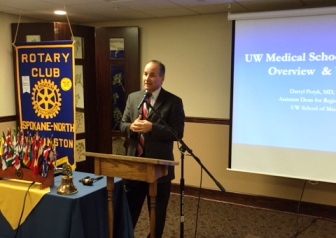UW School of Medicine -- Dr. Darryl Potyk and Catherine Brazil
Posted by Charles Rehberg
on Nov 16, 2015
Spokane North Notes
A weekly bulletin of the Spokane-North Rotary Club
November 16, 2015
Editors: Chuck Rehberg and Sandy Fink
Photos: Jim Minkler
Program Coordinator: Brad Stark
Welcome back!: After a leave of absence, Chad Haverkamp has returned to the club. Good to see you again!
‘Tis the season for sponsors: Holmes projects fund-raising coordinator Jodi Harland shared lists of possible corporate donors and encouraged club members to contact sponsors who can put support of our projects in their 2016 annual budgets. “We want to see more Platinum Sponsors at the $1,000 level,” Jodi said, adding, “we should shoot for $25,000 to $30,000 as next year’s goal.” About $14,000 was raised in support of projects for needy kids at Holmes Elementary this year.
Other clubs: JoAnn Barber of Spokane-West Rotary brought her order lists for holiday poinsettia plants and Jim Schindler of Aurora Northwest brought coupon books for that club’s “pick your cruise” prize. Contact them directly if you are interested.
What’s the best prescription for a Spokane med school?
Some call it a “turf war.” Others say it’s a “divorce.”
Whatever, the competition continues between the University of Washington and Washington State University to operate the emerging medical school program in Spokane.
 On Nov. 16, club members heard from Dr. Darryl Potyk, UW’s assistant dean for regional affairs for its school of medicine. Next week WSU representatives visit the club.
On Nov. 16, club members heard from Dr. Darryl Potyk, UW’s assistant dean for regional affairs for its school of medicine. Next week WSU representatives visit the club. Joining Dr. Potyk was Catherine Brazil, self-described as “a third generation Husky and fourth generation Spokane resident.” 

Brazil is UW director of Spokane and Eastern Washington relations. Working from UW’s area headquarters at 201 W. Main, she sets up events for the area’s 5,000 alums, talks with prospective students and seeks possibilities for more “innovation and research work within the Spokane area.”
Dr. Potyk, an internist, said UW’s med school has “been here for 40 years,” mostly coordinating medical education programs through “WWAMI,” the five-state collaboration of Washington, Wyoming, Alaska, Montana and Idaho.
Forty first-year med students are here now and the plan is to grow to 120 first-year students, Potyk said. Currently there are 18 second-year med students in Spokane, he said.
Potryk said some UW students even say “they got WWAMI-d,” meaning they wanted to be in Seattle, but were assigned to classes in Spokane. He added that after they take some classes here, many prefer the Spokane-based program. A map showed about a dozen eastern Washington venues with a UW med school presence. Some 200 UW students were involved in regional medical training.
“We actually have students who graduate UW Med School but have never set foot in a Seattle classroom,” he said.
Potryk has done medical education in Spokane for 20 years and has had his current title since 2013. When some saw that his tie matched WSU’s crimson color, he said he “wore his Cougar tie just by chance.”
He said there is “a minefield” of issues for the Washington legislature, and those in other WWAMI states, to sort through in determining who leads medical education here and how the collaborative efforts continue.
A WSU med school, a centerpiece of planning by the school’s late president, Elson Floyd, would take time to open, he said.
Potryk said WSU is submitting paperwork for various approvals in the next several weeks and if its first students were enrolled in 2016 or 2017, they would graduate in 2020 and, after, residencies and advanced training, the first doctors would not start practice until 2023.
“We can’t wait that long,” Potryk said.
Asked about the educational turf war and redundant expenses for taxpayers, Potryk said “for WWAMI, it’s a big divorce and there is a battle over custody of the kids (students).” He added: “People on the ground are on the same page in supporting the students. More medical education here is a good thing; the question is the capacity in Spokane.”
Asked about the urgent need for more primary care physicians, especially in rural areas, Potryk said “UW is number one nationally in training primary care physicians, but we can’t push students into that area.” He added that while primary care doctors typically earn about $130,000 a year, physicians in “super specialties” can earn three times as much.
When newly graduated doctors start their practices with average college debt of $300,000 to $400,000, “that makes primary care less attractive. And you don’t want a primary care doctor who doesn’t want to do primary care,” Potryk said.
Asked about integrating Spokane medical education with Kootenai County and other sites in North Idaho and Western Montana, Potryk said Spokane has lost some medical graduates and practitioners to Idaho, where reimbursements sometimes are better.
He also described “WWAMI safaris,” six-week rotations for certifications, to various clinics and hospitals in the region.
The thorough, thoughtful discussion of medical education in Spokane – with WSU’s perspective due next week – left club members convinced that no simple solution – like take two aspirin and call me in the morning – will suffice for the taxpayers, students and regional medical industry.
